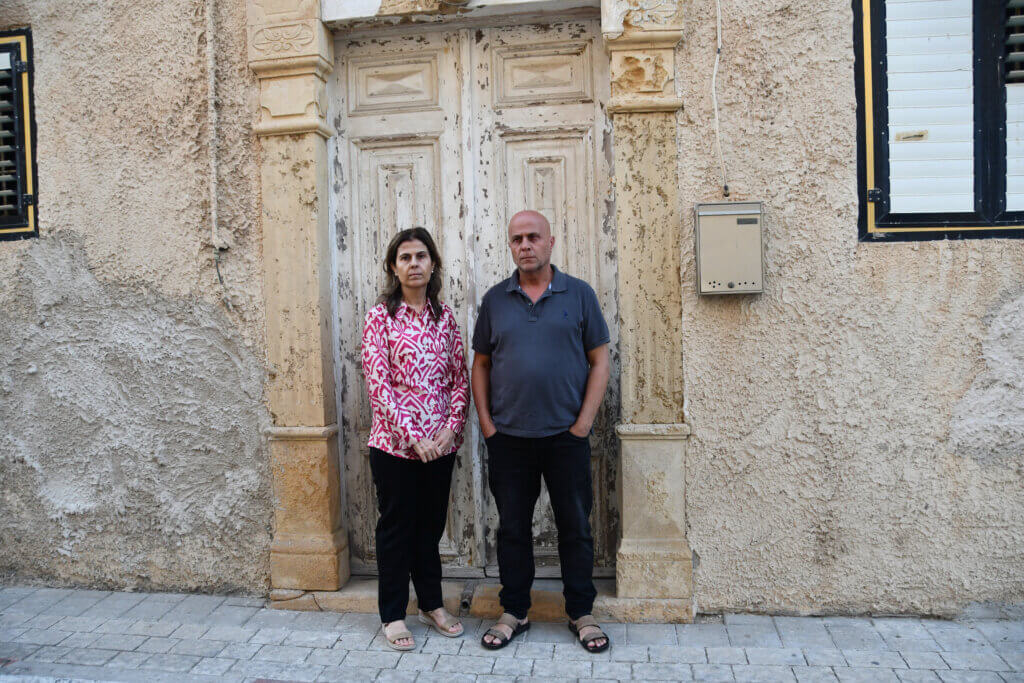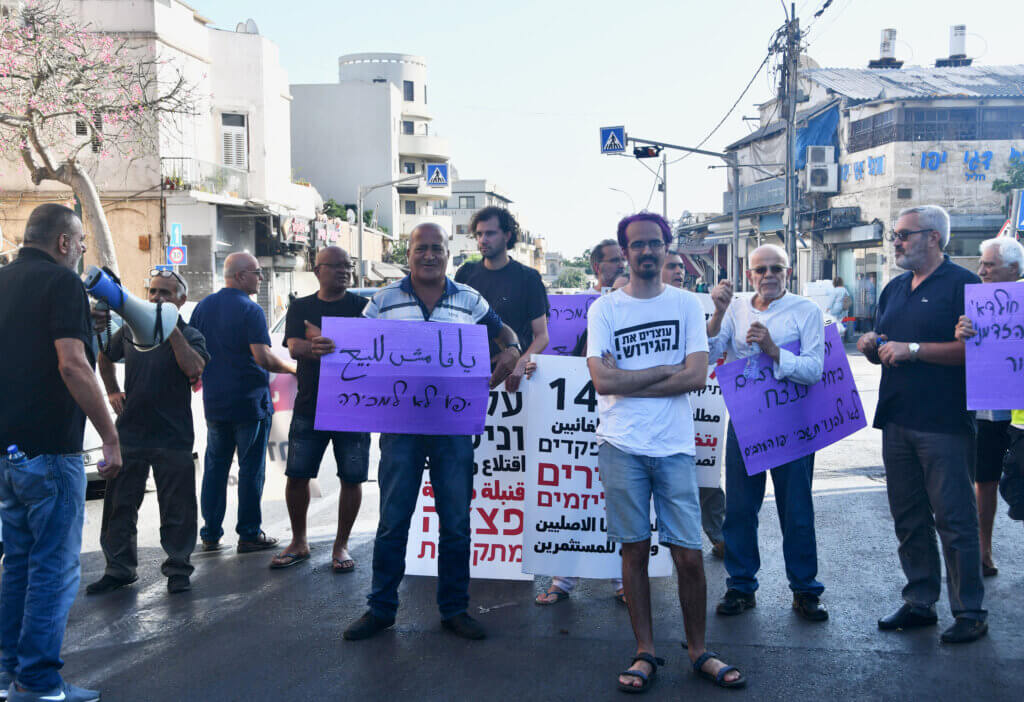Located near the Mediterranean shore, the historic Ajami neighborhood in Jaffa has become a battleground between the Israel Lands Authority (ILA) and the area’s veteran Palestinian residents. About 1,400 families have been served eviction orders from Amidar, a public housing company which in the past has said it’s simply doing ILA’s bidding. Amidar did not respond to Mondoweiss’ requests for comment for this article.
About 120,000 Palestinians lived in Jaffa before the establishment of the Israeli state in 1948. Yet prior to and during the state’s founding, Palestinians fled or were expelled by Zionist paramilitary forces from the port town in what is now known as the Nakba (or catastrophe in Arabic). Roughly 3,200 Palestinians remain in Jaffa’s Ajami district today as a result.
Under Israeli law, the properties left behind by Palestinians fleeing the Nakba are considered absentee or abandoned and fell under ILA ownership.
“[The state] just took their homelands,” Adv. Amir Badran, Tel Aviv-Jaffa city council member, said. “They’re speaking about Palestinians as absent, and their property is property of the state now, although [Israel] didn’t pay anything for them.”
Many Palestinians who stayed or returned to Jaffa after 1948 entered into key money agreements with the state turning them from previous homeowners into lessees. Through the Protected Tenant Law enacted in 1972 and originating from the British Mandate period, the Palestinian residents initially pay a large sum to own 60% of their homes while Israel controls the other 40%. Thereafter, the residents become protected tenants paying a significantly reduced monthly rent to Amidar for the duration of three generations. However, the three-generation period is misleading, explained Badran, as the state considers the tenant the first generation, his spouse, the second generation, and their child the third generation.
Now with many of these third-generation tenants above the age of 50 and housing prices in Tel Aviv-Jaffa skyrocketing, state authorities are knocking on tenants’ doors demanding they buy the unit or leave.

Pushed out for being Palestinian
Saleem Bilbisi, who has lived in his Jaffa home since he was five years old, is faced with an Amidar asking price of 2.8 million shekels (about $782,000) — a number his working-class family can’t afford.
“There are Jews who are living in houses within the same status, but [Israel is] not targeting them. It’s only targeting Arabs,” The 61-year-old said.
According to activists fighting the displacement in Jaffa, only around 400 families have the financial means to purchase the homes while the rest don’t. Yet for some families, money isn’t the issue.
The Hamati family says they can afford the roughly 4-5 million shekel price (about $1 million), but, according to them, ILA doesn’t want Palestinians in these homes.
“Amidar has no problem selling it [to me],” Jaffa resident Charlie Hamati explained. To him, he sees the main obstruction as ILA. “They think in an ideological way and don’t want Arabs.”
Hamati, whose family has been in Jaffa since 1931, wants to buy the whole housing unit, but only 2/3 of the property is for sale to him. This is because in 1950 the state allowed a Jewish family to inhabit part of the home for 15 years. So Amidar told him that the section of the house — which contains his bedroom and his children’s — isn’t his.
Like Sheikh Jarrah, Palestinians in Jaffa are enduring a slow and calculated process of expulsion. However, unlike Sheikh Jarrah, the government isn’t enacting these evictions at the hands of organized settler groups. Instead — activists claim — the state is attempting to push Palestinians out to make room for wealthy Jews from abroad willing to pay high prices for seaside property. ILA did not respond to Mondoweiss’ press inquiries.

Ethnic cleansing through real estate
The idyllic neighborhood of Ajami has an air of old Jaffa still present. Limestone walls, colorful shutters, and arched alleyways line the streets. Inside, the homes are adorned with black-and-white family portraits, high frescoed ceilings, and Gothic-style windows. But decades of municipal neglect have left the homes in disrepair with chipped paint and cracked walls.
Saleem’s sister, Fatima Bilbisi, fears even purchasing the remaining percent of the home won’t fix the renovation issue. In Israel, any homeowner wanting to modify or extend their home must first apply for a building permit through the local planning and zoning committee. Process for approval can take months and isn’t guaranteed.
“Even if you get the house, you have a limited period during which you are allowed to build a new house,” Fatima Bilbisi said. “So, [Israel] is putting very strict rules on us in order just to push us out.”
The families are working with local organizations to coordinate compromises between them and the government entities, with one such agreement allowing families to purchase the homes through loans from the Bank of Israel and financial assistance from the Tel Aviv-Jaffa municipality and ILA. However, these promises aren’t official as no written guarantee has been drawn up yet. The municipality confirmed a government team was established to significantly reduce property prices but the decision is still awaiting approval.
“In 1948, [Israel] kicked out people with guns and fear. Now they are doing it with money and real estate issues. It’s just another way of displacement.”
Fatima Bilbisi
In the interim, solidarity activists and residents with eviction notices are drawing attention to weekly Friday protests where they block traffic and demand Jaffa not be for sale.
As Jaffa’s housing crisis escalates, Fatima Bilbisi compares the current situation to Jaffa’s Nakba past.
“In 1948, [Israel] kicked out people with guns and fear,” Fatima Bilbisi said. “Now they are doing it with money and real estate issues. It’s just another way of displacement.”



2 of 2
Mr. Davis’s observations are confirmed by the IDF Intelligence Branch Report dated 30 June 1948, entitled “The Arab Exodus from Palestine in the Period 1 December 1947 to 1 June 1948.” After studying the document, Israeli historian Benny Morris stated that ‘the Intelligence Branch report goes out of its way to stress that the [Palestinian] exodus was contrary to the political-strategic desires of both the Arab Higher Committee and the governments of the neighboring Arab states. These, according to the report, struggled against the exodus – threatening, cajoling, and imposing punishments, all to no avail.” (Benny Morris, “The Causes and Character of the Arab Exodus from Palestine: The Israel Defense Force Intelligence Board Analysis of June 1948,: Middle Eastern Studies, Vol. XXII, no. 1, January 1986)
What happened in Palestine in 1947 and 1948 was described by eye-witness Nathan Chofshi, a Jewish immigrant from Russia who arrived in Palestine in 1908 in the same group as Polish born David Ben-Gurion (real name, David Gruen):
“…[W]e old Jewish settlers in Palestine who witnessed the flight [know] how and in what manner we, Jews, forced the Arabs to leave cities and villages…some of them were driven out by force of arms; others were made to leave by deceit, lying and false promises. It is enough to cite the cities of Jaffa, Lydda, Ramle, Beersheba, Acre from among numberless others.” (Jewish Newsletter, February 9, 1959).
Chofshi was deeply ashamed of what his fellow Jews did to the Palestinians: “We came and turned the native Arabs into tragic refugees. And still we dare to slander and malign them, to besmirch their name. Instead of being deeply ashamed of what we did and of trying to undo some of the evil we committed we justify our terrible acts and even attempt to glorify them.” (ibid)
1 of 2 for the record:
Between passage of the recommendatory only UNGA Partition Plan (Res. 181) and the declaration of the state of Israel effective 15 May, 60,000 Palestinians were expelled from Haifa by Zionist forces as were 75,000 from Jaffa in late April and early May. Many other Palestinian towns and villages were violently depopulated by Zionist forces and several documented massacres of Palestinians were carried out by Jewish forces, e.g., Deir Yassin.
Glubb Pasha, commander of the Arab Legion: “The story which Jewish publicity at first persuaded the world to accept, that the Arab refugees left voluntarily, is not true. Voluntary emigrants do not leave their homes with only the clothes they stand in. People who have decided to move do not do so in such a hurry that they lose other members of their family – husband losing sight of his wife, or parents of their children. The fact is that the majority left in panic flight, to escape massacre. They were in fact helped on their way by the occasional massacres…just enough to keep them running.” (John Bagot Glubb, A Soldier With the Arabs, London: Hodder & Stoughton, 1957)
John H. Davis, who served as Commission General of UNRWA at the time: “An exhaustive examination of the minutes, resolutions, and press releases of the Arab League, of the files of leading Arabic newspapers, of day-to-day monitoring of broadcasts from Arab capitals and secret Arab radio stations, failed to reveal a single reference, direct or indirect, to an order given to the Arabs of Palestine to leave. All the evidence is to the contrary; that the Arab authorities continuously exhorted the Palestinian Arabs not to leave the country. Panic and bewilderment played decisive parts in the flight. But the extent to which the refugees were savagely driven out by the Israelis as part of a deliberate master-plan has been insufficiently recognized.” (John H. Davis, The Evasive Peace, London: Murray, 1968) (cont’d)